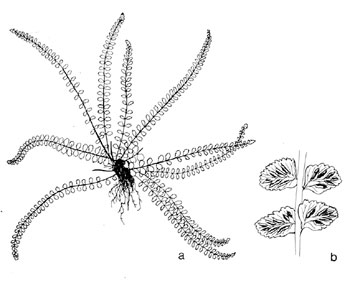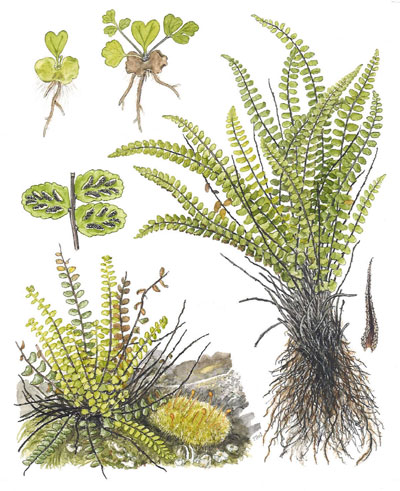| Asplenium trichomanes | ||
Maidenhair spleenwort | ||
|
Etymology
Trichomanes is the ancient Greek name for this fern, meaning "hair of the head", probably from tricho, hairy + manes, flowing.
Description
Rhizome: short-creeping, often branched, scales clathrate, black, or sometimes with brown borders, to 5 mm , lanceolate.
Frond: 20 cm high by 1.5 cm wide, evergreen, monomorphic or nearly so, but the sterile fronds are earlier and prostrate, blade/stipe ratio: 3:1 to 5:1. Stipe: a diagnostic feature (10x hand lens) is a narrow wing running the length of the stipe and rachis; brown-black or coppery, lustrous all the way to the end of the rachis , dark brown to black, filiform scales at base, then glabrous above, vascular bundles: 2 c-shaped, back to back, uniting to 1 upwards in an x-shape. Blade: 1-pinnate, linear, widest above the middle, tapering to either end, thin, glabrous or minutely hairy. Pinnae: 20 to 35 pair, opposite to subopposite, oblong, round at apex; margins finely dentate; veins free, evident. Sori: oblong to linear, about 1.5 mm long, , 2--5 pairs per pinna, indusium: translucent, pale tan, hidden by sporangia at maturity, on one side of the sorus, sporangia: brown, maturity: late summer to early fall. Dimensionality: spreading. Culture
Habitat: associated with rocks, and see comments under subtaxa.
Distribution: World, appears here and there on every continent except Antarctica.
Hardy to -35�C, USDA Zone 3.
Distinctive Characteristics
Young plants may be difficult to distinguish from A. platyneuron, but the latter's pinnae are eared upwards.
|
|
|
Notes
Subtaxa The diploid and quadriploid forms are given the designations ssp. trichomanes and ssp. quadrivalens. The former is said to be more delicate and have fewer sori. The stipes of both start out brown-black, but the diploid matures to a coppery color. Old fronds, having lost their pinnae, persist in the diploid, but fall in the quadriploid. The surprising difference, however, is the preference of ssp. trichomanes for acidic substrates and ssp. quadrivalens for calcareous rocks.
Subtaxa The diploid and quadriploid forms are given the designations ssp. trichomanes and ssp. quadrivalens. The former is said to be more delicate and have fewer sori. The stipes of both start out brown-black, but the diploid matures to a coppery color. Old fronds, having lost their pinnae, persist in the diploid, but fall in the quadriploid. The surprising difference, however, is the preference of ssp. trichomanes for acidic substrates and ssp. quadrivalens for calcareous rocks.
|
A linear sorus and indusium, the latter opening towards the costa, are signature characteristics in the genus. �BioImages: The Virtual Field-Guide (UK), photo � Malcolm Storey. |

Asplenium trichomanes. a) habit, b) fertile pinnae. �Illustration by V. Fulford from Ferns and Fern Allies of Canada, William J. Cody and Donald M. Britton, 1989, � Agriculture Canada, used with permission. |
